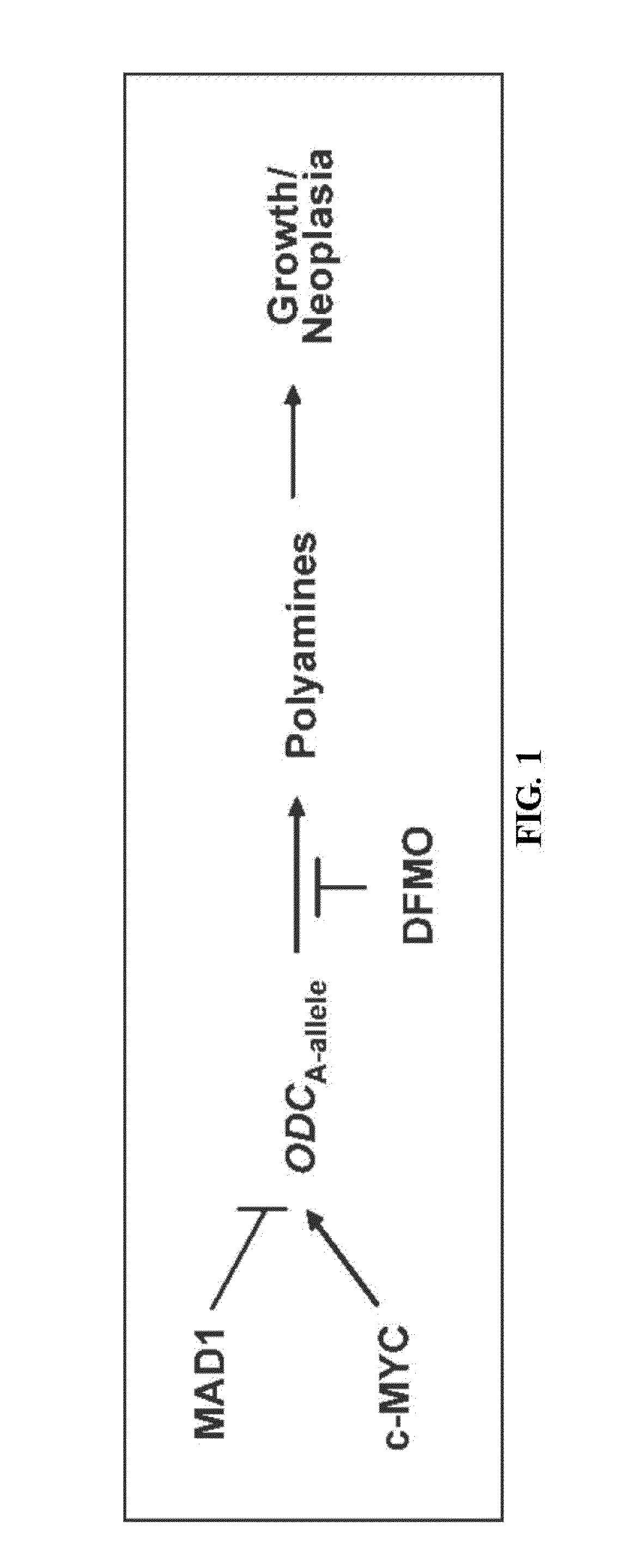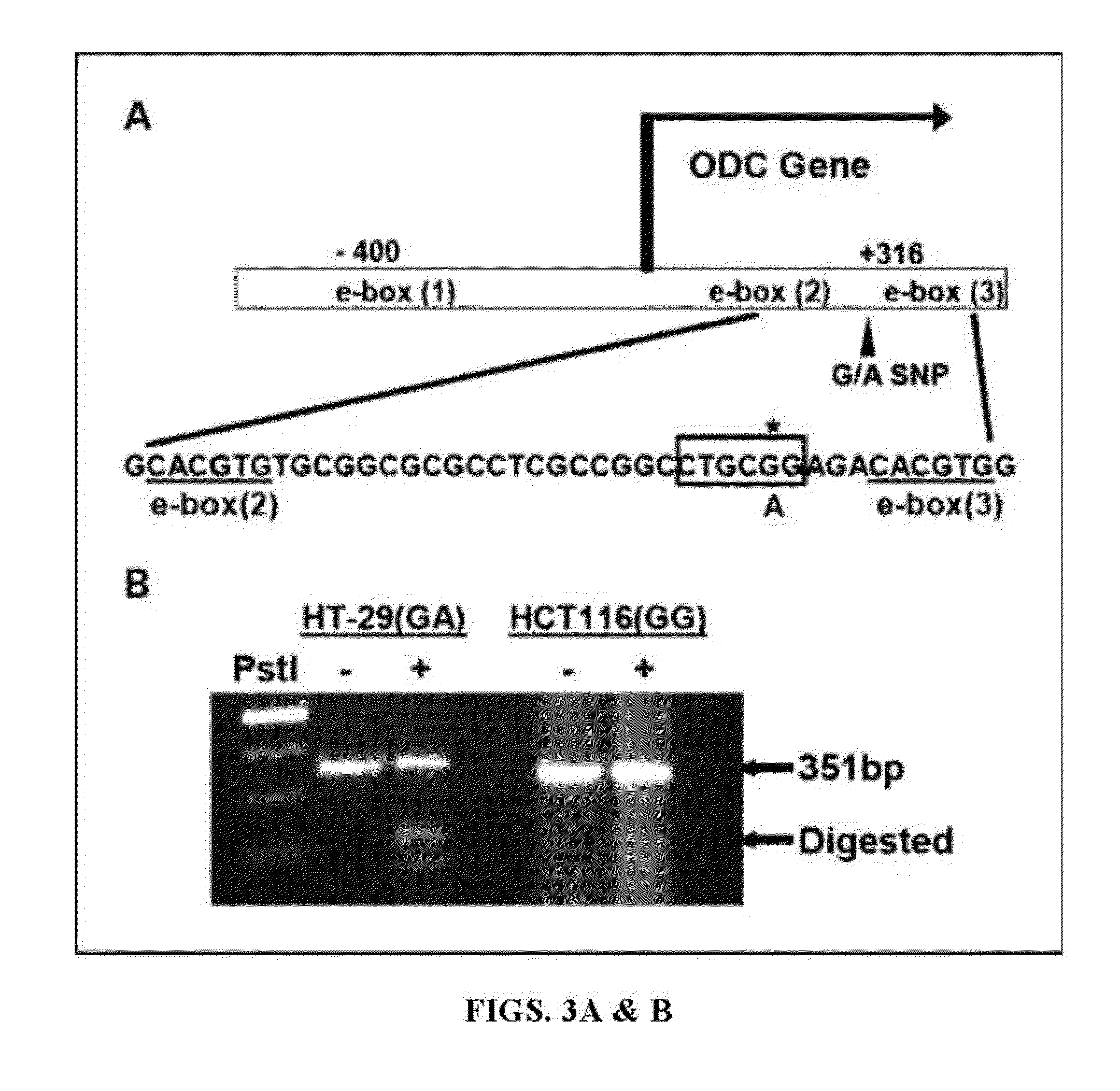Cancer prevention and treatment methods based on dietary polyamine content
a polyamine content and dietary technology, applied in the field of cancer biology and medicine, can solve problems such as the reduction of polyamine synthesis
- Summary
- Abstract
- Description
- Claims
- Application Information
AI Technical Summary
Benefits of technology
Problems solved by technology
Method used
Image
Examples
example 1
Epidemiologic Studies: ODC +316 SNP Associations with CRC-Specific Survival
[0203]Experimental Design:
[0204]The study included 440 incident CRC cases from the population-based UC Irvine Gene-Environment Study of Familial CRC (diagnosed 1994-1996 with follow-up through March 2008). The primary outcome was CRC-specific survival (CRC-SS) dependent on ODC genotype (GG vs. AA / GA). In human colon cancer cell lines, ODC allele-specific binding of E-box transcription factors was determined via western blotting and chromatin immunoprecipitation (CHIP) assays. ODC allele-specific promoter activity was determined using promoter constructs in combination with vectors expressing either the transcriptional activator c-MYC or the repressor MAD1.
[0205]Results:
[0206]Genotype-specific survival differences among CRC cases were limited to colon cancer cases: compared to ODC GG genotype cases (HR=1.00, reference) the adjusted CRC-SS hazards ratio (HR) was 2.31 (1.15-4.64) for ODC GA cases and 3.73 (0.93-...
example 2
Experimental Studies: ODC +316 SNP Regulation in Colon Cancer Cells
[0214]Cell Culture.
[0215]The human colon cancer cell lines HT29 and HCT 116 were maintained in McCoy's 5A medium (Invitrogen, Carlsbad, Calif.). All media used were supplemented with 10% FBS plus 1% penicillin / streptomycin solution (Invitrogen, Carlsbad, Calif.). Cultures were maintained at 37° C. in a humidified atmosphere of 5% CO2.
[0216]Genotyping Assay.
[0217]DNA samples from HT29 and HCT 116 cells were subjected to a PCR-RFLP procedure to detect the polymorphic PstI site. Sequences were amplified by PCR, using the following primers: 5′-TCTGCGCTTCCCCATGGGGCT-3′ (SEQ ID NO:1) and 5′-TTTCCCAACCCTTCG-3′ (SEQ ID NO:2). Each reaction contained—1 μl DNA, 4 pmol of each primer, 12.5 μl 2×PCR PreMixes buffer “G” (EPICENTRE Biotechnologies, Madison, Wis.) and 0.5 unit of Taq DNA polymerase, in a final volume of 25 μl. The expected size of the PCR product was 351 bp. After amplification, 10-20 μl of the PCR product were dig...
example 3
Differential Affects of ODC1 Genotype
[0226]This study involves analysis of patient data from the multicenter phase III colon adenoma prevention trial (Meyskens et al., 2008). 375 patients were enrolled, and the study was halted by the Data Safety Monitoring Board (DSMB) after 267 patients completed end-of-study colonoscopies (due to the study meeting its efficacy endpoints). The DSMB monitored all safety and efficacy endpoints. Blood specimens were collected on 228 consenting study patients for genotyping analysis after November 2002 (including 159 of 246 patients randomized before, and 69 of 129 patients randomized after this date), when the protocol was modified in light of data demonstrating the importance of the ODC1 SNP (2). ODC1 (rs2302615) genotyping was conducted on patient-derived genomic DNA using allele-specific TaqMan probes as described previously (Guo et al., 2000). Rectal tissue polyamine content was determined as described previously (Meyskens et al., 1998; Seiler an...
PUM
| Property | Measurement | Unit |
|---|---|---|
| pH | aaaaa | aaaaa |
| pH | aaaaa | aaaaa |
| time | aaaaa | aaaaa |
Abstract
Description
Claims
Application Information
 Login to View More
Login to View More - R&D
- Intellectual Property
- Life Sciences
- Materials
- Tech Scout
- Unparalleled Data Quality
- Higher Quality Content
- 60% Fewer Hallucinations
Browse by: Latest US Patents, China's latest patents, Technical Efficacy Thesaurus, Application Domain, Technology Topic, Popular Technical Reports.
© 2025 PatSnap. All rights reserved.Legal|Privacy policy|Modern Slavery Act Transparency Statement|Sitemap|About US| Contact US: help@patsnap.com



